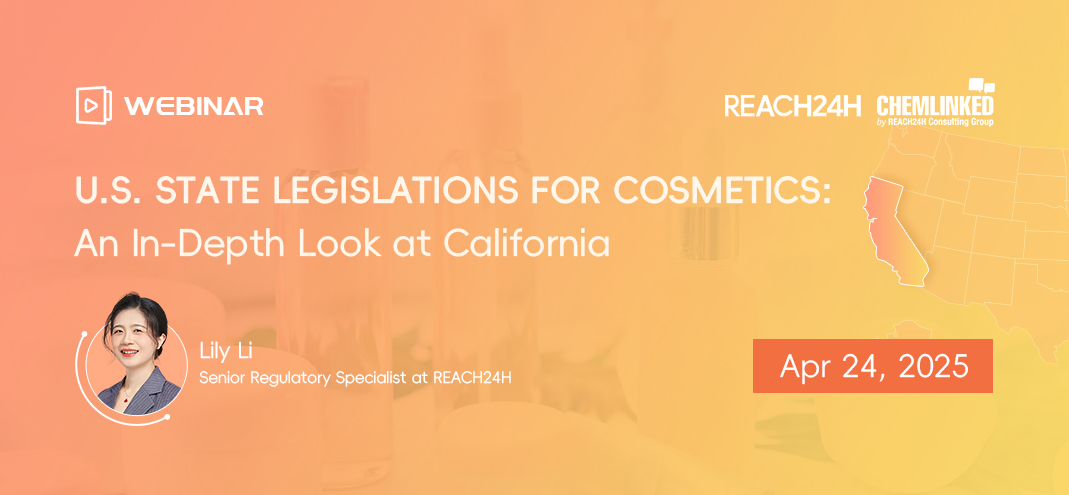September 2022: Global Cosmetic Regulatory Updates
This is a collection of global cosmetic regulatory updates, including cosmetic regulations in China, the EU etc.
🇨🇳China
China Conducts Another Round of Public Consultation on Safety and Technical Standards for Cosmetics
To reinforce cosmetic safety surveillance, China’s National Institutes for Food and Drug Control (NIFDC) announced on September 2, 2022, to solicit public comments on the formulation and revision suggestions of the Safety and Technical Standards for Cosmetics until September 15, 2022. (Read more)
New Cosmetics Supplementary Testing Method: China NMPA Stipulates Determination Method of Eight Prohibited Antifungal Agents
On September 13, 2022, China NMPA released a new cosmetics supplementary testing method, BJH 202202 Determination of Eight Components Including Elubiol in Cosmetics, which specifies the determination method of eight prohibited ingredients. (Read more)
China Implements the Electronic Registration Certificate System for Cosmetics from October 1, 2022
On August 19, 2022, China NMPA announced that the electronic registration certificate system for cosmetics would be officially implemented from October 1, 2022. Starting from the date, electronic registration certificates are issued for special cosmetics and new cosmetic ingredients approved for registration, as well as special cosmetics approved for registration certificate change and renewal. (Read more)
China NMPA Approves Six New Cosmetic Ingredients
In September 2022, China NMPA updated the notification information of six new cosmetic ingredients (NCIs). The basic information about these new NCIs is as follows:
1) Polylactic Acid (CAS No: 9051-89-2), notified on September 5, 2022
2) Saccharomyces / Pearl Ferment Lysate Filtrate, notified on September 13, 2022
3) Acetobacter / Lactobacillus / Saccharomyces / Camellia Sinensis Leaf Extract / Sucrose Fermet Filtrate, notified on September 13, 2022
4) Silicone Quaternium-26 (CAS No: 1551351-87-1), notified on September 15, 2022
5) Palmitoyl Dipeptide-18 (CAS No.: 1206591-87-8), notified on September 15, 2022
6) Bis-diisopropanolamine-PG-Propyl Dimethicone/Bis-Isobutyl PEG-14 Copolymer (CAS No.: 1253692-80-6), notified on September 20, 2022 (Read more)
Guangdong Provincial Medical Products Administration Clarifies that “Exosome Cosmetics” Are False and Exaggerated Claims
On September 7, 2022, Guangdong Provincial Medical Products Administration (MPA) published a popular science article, clarifying that “exosome cosmetics” were suspected of false and exaggerated claims.
The scientific community has not widely recognized the application effect of exosomes in the medical field. Related application trials are still in the clinical research stage. In addition, exosome-related ingredients neither are included in NMPA’s the Inventory of Existing Cosmetic Ingredients in China 2021 (IECIC 2021), nor have passed the registration or notification of new cosmetic ingredients.
Products claiming “exosome cosmetics” are suspected of misleading and deceiving consumers, falsely exaggerating claims, as well as expressing or implying medical effects. The regulatory authorities will investigate such products and punish the stakeholders soon.
China NMPA Implements Adverse Reaction Monitoring Regulation and Launches Monitoring System on October 1
The finalized Measures for the Management of Cosmetic Adverse Reaction Monitoring took effect on October 1, 2022. It provides systematic requirements for cosmetic adverse reaction monitoring in China.
On October 1, 2022, China NMPA launched the upgraded new version of the National Cosmetic Adverse Reaction Monitoring System as well. Where cosmetic registrants, notifiers, entrusted production enterprises, operators, or medical institutions find or learn any cosmetic adverse reaction, they shall submit a report through the system. (Read more)
China Issues Seventeen Group Standards in September
China issued seventeen group standards in September. The basic information is as follows:
| Type | Release Date | Initiator | Group Standard | Implementation Date / Deadline for Comments |
| Effective | Sept. 15 | Beijing Daily Chemical Association | Guidelines for Efficacy Evaluation of Cosmetics Containing Plant Resources with Chinese Characteristics | September 30, 2022 |
| Sept. 16 | Guangdong Cosmetics Association | T/GDCA 012-2022 Evaluation Method of Fragrance Retention for Hair Products | October 1, 2022 | |
| To be effective | Sept. 28 | Shanghai Society of Toxicology | T/SHSOT003-2022 Cosmetic Sensory Analysis – General Guidance | October 15, 2022 |
| T/SHSOT004.1-2022 Guidelines for the Optimization of Standard Methods for In Vitro Toxicity Testing – Part 1 General Principle | ||||
| T/SHSOT004.2-2022 Guidelines for the Optimization of Standard Methods for In Vitro Toxicity Testing – Part 2 Test Methods for In Vitro Reconstructed Human Epidermis Model for Skin Irritation Testing Optimization | ||||
| T/SHSOT005-2022 Integrated Approaches for Testing and Assessment for Eye Irritation Based on BCOP and CAMVA Method | ||||
| T/SHSOT006-2022 Integrated Approaches for Testing and Assessment for Skin Corrosion and Irritation Based on Reconstructed Skin Model | ||||
| Draft | Sept. 7 | China Association of Fragrance Flavour and Cosmetic Industries | Cosmetic Ingredients – Acetylneuraminic Acid | October 10, 2022 |
| Cosmetic Ingredients – Diethylamino Hydroxybenzoyl Hexyl Benzoate | ||||
| Cosmetic Ingredients – Benzophenone-4 | ||||
| Cosmetic Ingredients – Octocrylene | ||||
| Sept.14 | Shanghai Society of Toxicology | Testing Approach for Assessing Mildness (No Irritation) of Rinse-off Products Based on Skin
Lipid Barrier |
October 15, 2022 | |
| Sept. 15 | Guangdong Daily Chemical Chamber of Commerce | Assessment Requirements for Quality Grading and Forerunner – Mask | October 14, 2022 | |
| Assessment Requirements for Quality Grading and Forerunner – Skin Care Cream | ||||
| Assessment Requirements for Quality Grading and Forerunner – Skin Care Lotion | ||||
| Assessment Requirements for Quality Grading and Forerunner – Facial Washing Milk, Facial Washing Cream | ||||
| Assessment Requirements for Quality Grading and Forerunner – Oral Rinses |
🇪🇺European Union
EU to Impose Strict Restrictions on Synthetic Microplastics in Cosmetics
On September 5, 2022, the EU released a draft regulation which amended Annex XVII to Regulation (EC) No 1907/2006 Concerning the Registration, Evaluation, Authorisation and Restriction of Chemicals (REACH). This draft aims at imposing tighter restrictions upon products containing intentionally-added microplastics. For cosmetics subject to this draft, transitional periods ranging from 4-12 years are proposed. (Read more)
EU Adopts Amendments Concerning CMR Substances to the Cosmetics Regulation
Early this year, the EU launched a public consultation on the draft Commission Regulation concerning the use of CMR substances (substances classified as carcinogenic, mutagenic or toxic for reproduction) in cosmetics. On September 16, 2022, the EU introduced the finalized version of this Regulation. According to it, the adopted amendments will apply to all Member States from December 17, 2022. (Read more)
EU to Extend the Individual Labelling Requirement for 56 Newly Identified Fragrance Allergens in Cosmetics
On September 15, 2022, the EU introduced 56 newly identified fragrance allergens in cosmetics in a draft Commission Regulation notified to the WTO. Subject to the individual labelling requirement, these newly identified fragrance allergens shall be indicated in the list of ingredients when their concentration exceeds 0.001% in leave-on products or 0.01% in rinse-off products. The draft is open for comment until November 14, 2022. (Read more)
EU SCCS Releases the Final Opinion on Genistein and Daidzein
On September 27, 2022, EU Scientific Committee on Consumer Safety (SCCS) released the final opinion on Genistein and Daidzein. According to the safety assessment based on available relevant data, and in consideration of the potential endocrine disrupting properties of phytoestrogens, the SCCS is of the opinion that:
- the maximum use of Genistein in cosmetic products of 0.007% is safe;
- the maximum use of Daidzein in cosmetic products of 0.02% is safe. (Read more)
[Read more global regulatory updates at ChemLinked]
Reference Links
- August 2022: Global Cosmetic Regulatory Updates
- Cosmetic Regulatory Updates in China | July 2022
- Updates on Cosmetic Regulations in China | June 2022
Contact Us
We are devoted to providing professional global market access consultations and customized regulatory compliance services for cosmetic companies. If you need any help with global cosmetic regulatory compliance, please feel free to contact us.
Tel: +86-571-87103817
Email: customer@reach24h.com
News Source: ChemLinked

Market | Chemical | Food | Cosmetic | BaiPharm | Agrochemical
REACH24H Consulting Group launched ChemLinked in 2012 as a leading service provider of comprehensive regulatory information and compliance solutions, meeting the growing demand for clear and concise regulatory advice and market intelligence in Asia, especially China.
You can register for a membership to read the latest news limitlessly every day on ChemLinked.


